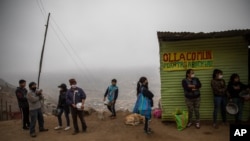U.N. agencies say a lack of money is threatening the lives of millions of people in developing countries from COVID-19-related hunger and disease.
The United Nations recently appealed for more than $10 billion to help hundreds of millions of people in the poorest, worst-hit countries in the world survive the pandemic. Nearly half the amount of the updated appeal is slated for food assistance, with an additional $500 million to be spent on famine prevention.
However, the international response has been tepid since the U.N. launched its first of three Global Humanitarian Response Plans for COVID-19 in March, asking for $2 billion. To date, only $1.7 billion of the $10.3 billion needed has been received.
The U.N. warns the number of hungry people caught in a state of crisis could increase from the current 149 million to 270 million before the end of the year without international aid.
World Food Program spokeswoman Elisabeth Byrs said the agency’s director, David Beasley, has warned the world runs the risk of a famine of biblical proportions.
“Millions of the world’s very poorest families have been forced even closer to the abyss," Byrs said. "Livelihoods are being destroyed at an unprecedented level. Now, to prevent the worst, WFP is scaling up its operation to provide food assistance to 138 million people who face a desperate level of hunger.”
The U.N. children’s fund runs humanitarian operations in 155 countries and territories. It said it had received less than half of the $2 billion needed to support its activities for women and children.
UNICEF spokeswoman Marixie Mercado said projections by the Johns Hopkins Bloomberg School of Public Health show COVID-19 is affecting children in ways that will have lasting impact.
She said the study showed that 6,000 children could die from preventable causes every day over the next six months because of disruptions in essential services related to COVID-19.
“The data from the first four months of 2020 already show a substantial drop in the number of children completing three doses of the vaccine against diphtheria, tetanus and pertussis. … We know that at least 30 measles vaccination campaigns were or are at risk of being canceled," Mercado said. "And, this, of course, could result in further outbreaks in 2020 and beyond.”
The pandemic also is having a devastating impact on education. UNESCO estimated that nearly 1.2 billion students in 150 countries had been affected by school closures, causing mental and psychological distress for many. And according to the U.N. Population Fund, millions of girls and women are subject to violence because of COVID-19 lockdown measures.









